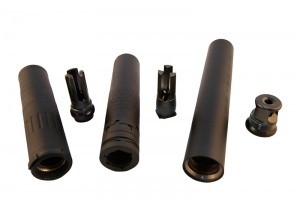June 25, 2013
[caption id="attachment_16445" align="alignleft" width="300"] From left to right: AAC M4-2000, Silencerco Saker, Thunder Beast 30BA. All these mounting system have their own pros and cons.[/caption]
Quick-Attach rifle suppressors are some of the most popular models on the market because of their versatility.
Even though they are extremely popular, I hear people all the time who claim there aren't any advantages to choosing a quick-attach. These people often have a vested interest in steering people toward direct-thread models, and they often make valid points; but, I do believe there are real advantages offered by quick-attach systems.
Unfortunately, the terms 'Quick-Attach' and 'Quick-Detach' (QD) can be a bit misleading.
I talk to people all the time who assume a direct-thread model cannot be removed at all - which couldn't be further from the truth. In fact, a direct-thread suppressor can typically be attached and removed just as easily as quick-attach models (although it does require a few more turns to thread it on or off).
From left to right: AAC M4-2000, Silencerco Saker, Thunder Beast 30BA. All these mounting system have their own pros and cons.[/caption]
Quick-Attach rifle suppressors are some of the most popular models on the market because of their versatility.
Even though they are extremely popular, I hear people all the time who claim there aren't any advantages to choosing a quick-attach. These people often have a vested interest in steering people toward direct-thread models, and they often make valid points; but, I do believe there are real advantages offered by quick-attach systems.
Unfortunately, the terms 'Quick-Attach' and 'Quick-Detach' (QD) can be a bit misleading.
I talk to people all the time who assume a direct-thread model cannot be removed at all - which couldn't be further from the truth. In fact, a direct-thread suppressor can typically be attached and removed just as easily as quick-attach models (although it does require a few more turns to thread it on or off).
If the quick attachment and removal aren't the main benefits of a quick-attach, what is?
1) Most quick-attach suppressors contain a locking mechanism of some type. For medium to high volume shooters, the locking mechanism is a huge asset because it keeps the suppressor from coming unscrewed on its own. 2) The flash hider or muzzle brake that the suppressor attaches to also acts as an adapter. If you want to run the same suppressor on multiple weapons with different thread pitches, then you can put the appropriate quick-attach muzzle device onto both barrels and the suppressor will fit them with no additional adapters needed. This makes quick-attach suppressors popular for people who want to run a larger caliber suppressor on smaller caliber weapons (like putting a 7.62mm suppressor on a 5.56mm rifle). 3) The muzzle device will act as a thread protector on your weapon. With a quick-attach suppressor, you will leave the muzzle device torqued in place - and that will permanently protect the threads on your barrel.What are the downsides to a quick-attach suppressor?
The main downside is a slight loss in accuracy. Where a direct-thread suppressor will often increase your weapon's accuracy, a quick-attach suppressor can have the opposite effect. Keep in mind that we're not talking about a huge loss of accuracy; but, if you're a long distance shooter, every little bit counts. There are, of course, several factors that will impact accuracy:- If you use a suppressor with a larger bore size, it will tend to have less of an impact on accuracy overall (although it will also be less efficient at reducing sound). Remember that many suppressors will actually increase accuracy, so a larger bore wouldn't necessarily be a good thing in that case...
- The design and tolerances of the baffle stack will impact accuracy.
- The mounting system will also have an impact on accuracy.





